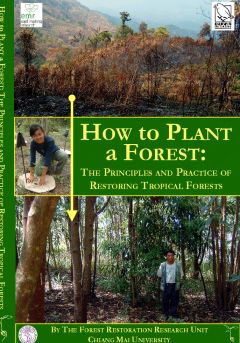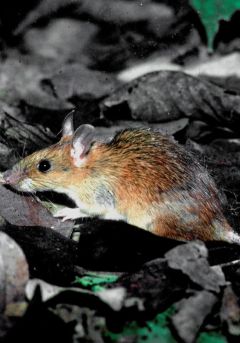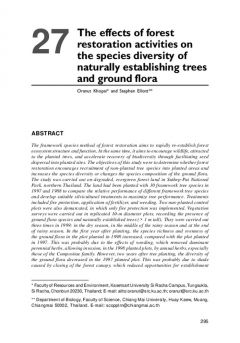The Nan Project, directed by Assist. Prof. Dr. Dia Shannon comprises 3 research initiatives:
-
From a Bare Mountain to a Regenerated Forest: compared landscape planting designs for forest restoration in Nan Province, sponsored by the National Science and Technology Development Agency (NSTDA), 2017 to 2020.
-
Forest Landscape Restoration and Community Well-being: supported by the Program Management Unit on Area Based Development (PMU A), 2020 to 2021.
-
Evaluating Changes and Ecosystem Services of Nan Restored Forests: funded by the National Science and Technology Development Agency (NSTDA), 2021 to 2022.
The research spans three districts of Nan Province—Pua, Phu Phiang and Wiang Sa—with three plots in each district. The project commenced with a survey of reference forest remnants, near the restoration sites, including i) the Nam Kaen - Nam Sa Watershed Forests (Phu Phiang District), supervised by the Royal Forest Department; ii) Mon Hin Kaew Community Forest (Pua District) and iii) Ban Muang Noeng Community Forest (Wiang Sa District). The survey involved documenting tree density, species diversity and phenology, as well as bird diversity, over three years. Such data were then compared with the same in restoration forests, established in the 3 districts.
Knowledge of the framework species method of forest ecosystem restoration was transferred to local communities and restoration plots of various sizes were planted with a range of indigenous framework tree species. Post-restoration activities include frequent weeding and fertilizer application, as well as the cutting of firebreaks in the dry season. Monitoring focused on survival and growth rates of each species, as well as the diversity of soil microbial communities. Ecosystem services, provided by the restored forests, including climate control, were evaluated, along with forest products used by local people. The effects of restoration on the quality of life of local people was also assessed. Currently, villagers who are project members continue to actively contribute to the care of the restored forest, to ensure its long-term health and growth.
In collaboration with:
Biodiversity
Biodiversity recovery is one of the main aims of forest restoration - but what to measure? Plants? Birds? Mammal? Learn simple monitoring techniques here.
61: Recovery of Lichen Diversity During Forest Restoration in Northern Thailand
ABSTRACT: This study investigated the recovery of lichen diversity during restoration of upland evergreen forest in northern Thailand. Lichen diversity and species frequencies were recorded within...
62: Leaf flushing during the dry season: the paradox of Asian monsoon forests
Aim Most deciduous species of dry monsoon forests in Thailand and India form new leaves 1–2 months before the first monsoon rains, during the hottest and driest part of the year around the spring...
63: How to Plant a Forest: The Principles and Practice of Restoring Tropical Forests
FORRU-CMU's second practical training manual was published in 2005. It includes generic principles of restoration theory and practice, applicable throughout the tropics, as well as descriptions...
64: Seed Dispersal of Three Framework Tree Species and Seed Predation of Manglietia garrettii Craib
ABSTRACT: Deforestation is a serious problem in northern Thailand. Framework tree species are native forest trees that help to accelerate natural forest regeneration. Planting them can, therefore,...
65: Research needs for restoring tropical forests in Southeast Asia for wildlife conservation: accelerated natural regeneration
Accelerated natural regeneration (ANR) is a relatively cheap method of reforestation, which encourages natural establishment of indigenous trees and shrubs. It requires a low input of labour, but...
66: Trees of Knowledge
Early in 2002 Eden began supporting the Forest Restoration Research Unit (FORRU for short), a small research team at Chiang Mai University (CMU) in northern Thailand, whose mission is to find out...
67: Eden helps restore Thailand’s tropical forests
Eden's new overseas partnership project works with hill-tribe communities in northern Thailand to realise the dream that destruction of Earth's tropical forest can be revesed. As human population...
68: Effects of Mature Trees on Seedling Establishment on Deforested Sites
In Thailand, accelerated natural regeneration (ANR) of forest on degraded land has not been successful due to lack of knowledge about the natural processes of forest regeneration. The role of...
69: The Diversity of Small Mammal Communities in FORRU's Reforested Sites
Here, our BSc student, Jenpop Thaiying, presents what happens to small mammal communities in the initial stages of forest restoration. In an earlier, pre-FORRU study, another BSc student, Somyod...
70: The effects of forest restoration activities on the species diversity of naturally establishing trees and ground flora
The framework species method of forest restoration aims to rapidly re-establish forest ecosystem structure and function. At the same time, it aims to encourage wildlife, attracted to the planted...











